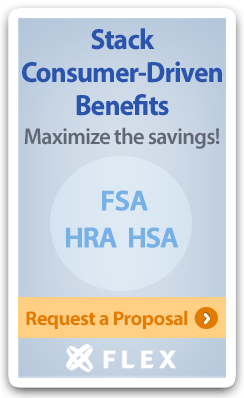Benefits Buzz
5 Things to Consider When Implementing an HRA

Health Reimbursement Arrangements (HRAs) can be a great way for employers to control their benefits budgets without sacrificing quality of coverage for their employees. There are several different types of HRAs available in the market, but perhaps the most popular is the Integrated HRA. These HRAs work alongside a group health plan to reimburse employees for out-of-pocket expenses. Only those employees enrolled in the group health plan can participate in the HRA.
Integrated HRAs offer a great deal of flexibility, so they are a perfect way for employers to design a benefits program that fits the needs of their organization and their employees. When deciding to implement an Integrated HRA, there are five important factors that employers should consider.
What’s the Goal of the HRA?
Each employer’s situation is unique, and so are their reasons for moving to an HRA strategy. Identifying these reasons can help guide the HRA design.
-
Is the employer looking for premium relief, or to try to control renewal increases?
-
Are they implementing a high deductible plan for the first time, and looking for a way to soften the blow for employees?
- Do they want to use the HRA as a bridge to an HSA plan to be offered down the road?
Once the need for an HRA is understood and addressed, it will be easier to design an HRA plan to accomplish the employer’s specific goals.
What are the Eligible Expenses?
For an integrated HRA, there are four typical categories for eligible expenses:
-
All 213(d) Expenses – This encompasses all out-of-pocket expenses related the healthcare, including medical plan deductibles, co-pays, and coinsurance, dental and vision expenses, and over-the-counter healthcare items.
-
Deductible Expenses Only – This is by far the most common option and includes only the deductible expenses associated with the employer’s group health plan.
-
All Health Plan Related Expenses – This includes deductible, co-pays, and coinsurance associated with the employer’s group health plan.
- Limited Purpose – This is an HSA-compatible option that only covers dental and vision expenses
The types of expenses that will be reimbursable under the plan are an important consideration, as they will have an impact on the overall utilization of the plan. An HRA that reimburses all 213(d) expenses will most likely have a higher employee utilization rate than one that only reimburses deductible expenses, which increases the employer’s exposure.
How Will the HRA be Designed?
Once the eligible expense categories have been decided upon, the next step is to design the reimbursement structure. There are myriad ways to design the reimbursement structure, but here are some common options:
-
First Dollar – The HRA reimburses employees immediately upon the first claim.
-
Employee Corridor – Employees must meet a certain dollar amount out of their own pocket before the HRA reimbursements begin.
-
Sandwich – The employee and the HRA alternate payment. For example, the employee would pay the fist $500 in deductible expenses, then the HRA reimburses the next $1,500 in deductible expenses, and the employees pays the final $1,000 in expenses.
-
Percentage Split – The HRA reimburses a set percentage of eligible expenses. For example, the HRA reimburses 80% of eligible expenses and the employee is responsible for the remaining 20%.
- Post-Deductible – HRA reimbursements don’t begin until after the employee meets the health plan deductible. This option is often used to reimburse coinsurance expenses on a high deductible health plan but still allow employees maintain HSA eligibility.
The reimbursement structure will have the biggest impact on the overall HRA utilization and the employer’s total exposure. Plans with an upfront employee corridor or plans that kick in post-deductible will help employers to keep their costs down. Alternately, HRAs with a first dollar benefit will provide a richer benefit for employees, but also increase the employer’s exposure.
Will Unused Funds Roll Over?
HRAs allow for rollover of unused funds, but it is not a requirement. It’s up to the employer to determine if employees will be allowed to roll over unused funds to the next plan year, or if unused balances will be forfeited at the end of the plan year.
There are many options to consider when it comes to the handling of unused funds:
-
Will employees be permitted to roll over unused funds?
-
If funds roll over, will there be a cap on the accrued total? For instance, some employers limit the total rollover balance to the amount of the health plan deductible.
-
Will 100% the unused funds will roll over? Or will the rollover be limited to a certain dollar amount or percentage of unused funds?
- When can employees access rollover funds? Some plans impose a time limit to spend rollover funds, such as 90-days into the new plan year.
Allowing for rollover of unused funds helps to boost the consumer-driven properties of the HRA. If employees think of the HRA money as their own and know that they can keep unused funds to spend in future plan years, they may be less inclined to spend it. Conversely, if employees know that any unused funds will go away at the end of the year, then they might adopt a “might as well spend it now” mindset when it comes to the HRA.
Most employers that Flex works with do not allow for rollover of unused funds on their HRAs. One important reason for this is that it helps the employer to keep costs down. If all unused funds revert to the employer at the end of the year, it will limit the employer’s exposure and increase their overall savings.
How Will Claims and Reimbursements be Handled?
Employers can handle HRA administration on their own, but this is a task best left to the professionals. The IRS requires that all HRA claims be substantiated before reimbursement is issued. Substantiation must include specific information such as the date and the amount of the expense, the name of the person for whom the expense was incurred, the provider’s name, and a description of service.
There are three main ways that HRA claims can be substantiated:
-
Manual Claims – The participant submits a claim to the HRA administrator along with a copy of the Explanation of Benefits from the insurance carrier or an itemized bill from the provider.
-
Electronic Data Transfer – The HRA administrator receives a claims feed from the insurance carrier with all the necessary claims information.
- Debit Card Transactions – Participants use debit cards to pay for eligible expenses directly from the HRA. Debit cards represent payment at the point of service, so no reimbursement is issued. It’s important to note that debit cards cannot be used with all HRA plan designs.
Reimbursements are issued once claims have been substantiated and processed by the HRA administrator. These are usually done via check or direct deposit paid directly to the employees. However, some employers prefer to receive a payment report from the administrator and issue reimbursements on their own, and some HRA administrators may offer an option to pay providers directly.
In most cases, the reimbursements are made using the employer’s funds, and the employer will have a decision to make about how often reimbursements are issued. Reimbursement schedules can vary by administrator, but typical options include daily, weekly, biweekly, semi-monthly, or monthly. The frequency of payments can typically be customized to the employer’s preference, depending on their unique situation and cashflow.
The Bottom Line
Addressing these five important factors in advance will make the HRA implementation easy for everyone. There are so many options available to employers when it comes to Integrated HRAs that making the switch to an HRA solution may seem overwhelming at first. By doing their homework and digging into the details, employers can design a plan that will not only meet their immediate needs, and the needs of their employees, but also help to achieve their desired outcome.
Looking for an HRA Solution?
Flex offers HRAs built with employers in mind. We’ve got the tools and resources employees want, along with the service and support employers need.

